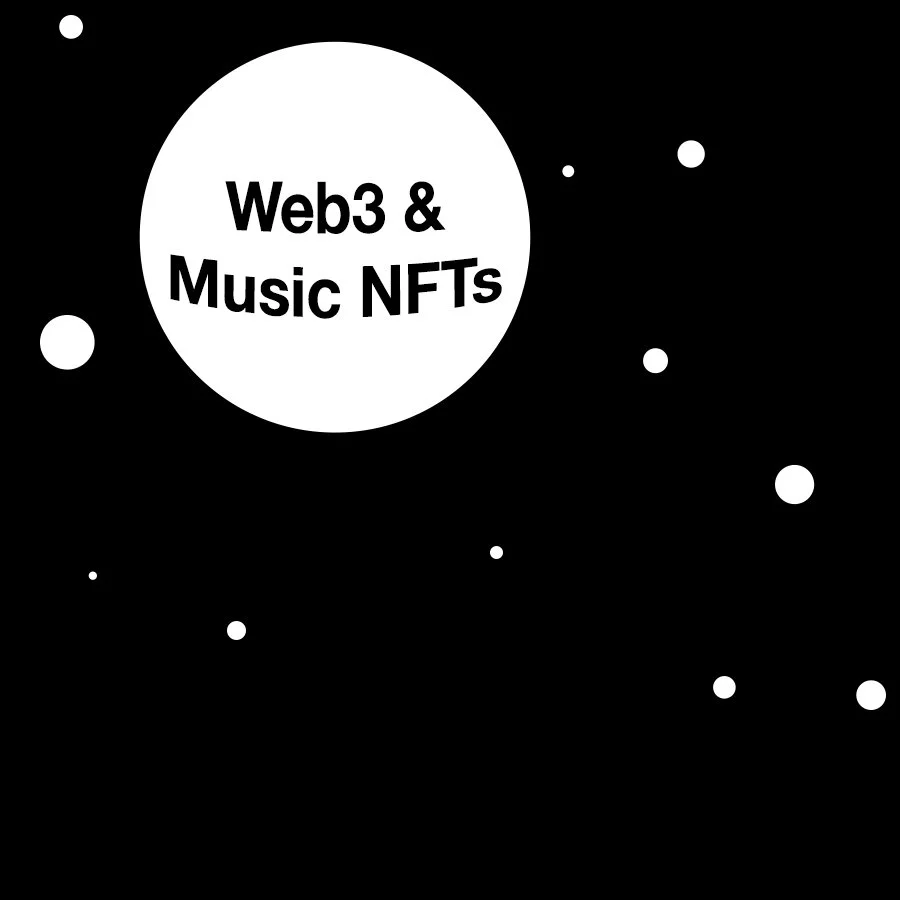Web3 Music & Music NFTs: A Simplified Guide
I’m writing this simplified guide to web3 & music NFTs for the complete beginner to become more familiar and get a better understanding of the space as it continues to grow in utility and popularity.
This is put together as a series of casual FAQs an interested music NFT creator or collector may have, or just a casual music fan trying to understand what all the hype is about.
The goal is that after reading this you know what an NFT is, how music NFTs are being used, and where to get started on your web3 music journey.
Let’s go!
Definitions and Buzz Words to know
Web3 (Web 3.0) - Internet services for website applications built on blockchain technology. Web3 is more decentralized, open, and user focused. Ultimately, allowing for true ownership.
At the moment our content, data, finances, and more are at the mercy of whichever platform or institution we’ve signed up for. Terms, rules and regulations can change at any time, either for or against you.
Web 1.0 - Early internet days where webpages consisted of read-only and hyperlinked content.
Web 2.0 - The internet as we know it now, consisting of user-generated content, collaboration and participatory platforms. We can now read and write content on the internet.
Centralization - Administrative powers of authority are concentrated to a few people.
Decentralization - Distributes administrative powers of authority to a less concentrated area.
Blockchain - A distributed digital ledger, structured as a chain of blocks. Each block contains specific data dependent on the blockchain, as well as a hash (or fingerprint) from the previous block and one from the current block, linking them together to create a chain. All transactions contained in these blocks are visible and can be verified.
Crypto Wallet - A cryptocurrency wallet contains your public and private keys. Your public key is your address used to send and receive crypto funds and NFTs. Your private key is like your password, don’t give that out. Crypto wallets can be physical (Ledger) or digital (MetaMask).
NFT (Non-Fungible Token) - Digital assets or collectibles stored on the blockchain, and used to represent ownership of unique items, such as - art, music, in-game assets, etc.
They are built with features so they cannot be replicated, counterfeited, or printed on demand.
Mint - Or minting, simply means to publish your token to the blockchain. Turning it from a digital file to a digital collectible.
WEB3 Music & MUSIC NFTs Explained
What are NFTs used for and why use them?
NFTs are used to represent ownership, to trade or even give extra utility to digital collectibles.
The benefit of NFTs are that they are decentralized items, you own it and it can’t be taken away from you.
Centralized items, on the other hand, like movies on Netflix or songs on Spotify can be removed anytime. You may miss a payment, their catalogue may change, or a platform can become irrelevant over time.
NFTs can be - Music, art, in-game accessories, represent real world physical items, photography, video, virtual assets, and more.
What are music NFTs?
Music NFTs are a new collectors item, a digital collectible for music.
With music NFTs, as a collector (NFT holder) you can take part ownership in an artists creation to:
Own a limited edition of a song to hold or trade later
Support your favourite artist where funds go directly to them with no middle man
Invest with an artist - where artists offer royalty and revenue splits with their collectors
Get extra utility - social tokens and rewards for collectors like merch and tickets
As an music NFT creator, you give your fans a whole new way to engage and more importantly own a piece of your work. You allow for your most loyal fans to support and invest in your career long term.
What are the Types of Music NFTs?
There are many ways to structure an NFT, and many more to come, but the most common use case for music NFTs at the moment are as follows:
1-of-1 NFT - A single piece of artwork with music attached, there is a single owner.
Royalty NFT - The artist decides what percentage to split with collectors. Involves automatic royalty collection and splits with all owners of the NFT.
Multi-creator Music NFT - When there are multiple collaborators who created the NFT. This involves complicated splits dispersed to the various creators of the NFT
Fractionalized Music NFT - A way to crowd fund ownership of a music NFT with multiple people, each person who pitched in would own a fraction of the NFT and therefore a fraction of any perks involved with the asset.
Where Can I get Involved with Music NFTs?
Music NFTs can operate on all sorts of blockchains networks. Some NFTs are only available on certain networks, so knowing where your NFT operates on is important. Ethereum is by far the most popular (and expensive) blockchain network for NFTs.
Top NFT Networks - Ethereum, Flow, Polygon, Tezos
You can still take a look at all the NFTs available, and even look at blockchain transactions any time without even having a crypto wallet. You just won’t be able to buy and sell yet.
Check out some of these awesome music NFT platforms and marketplaces making big moves in web3 right now.
Web3 Music Marketplaces & Platforms
Opensea.io - The first and largest NFT marketplace.
Zora - A universal media registry protocol. Artists publish creative media, earn money for their work, and share with it others.
Catalog - Built on top of Zora, Catalog is a digital record shop and music community for artists to press 1-of-1 digital records, and fans to discover and engage.
Sound.xyz - A collaborative music movement. Artists host launch parties where fans can show their early support through an NFT. The NFT allows fans to own a moment a leave a public comment solidifying their early support.
Bolero - Allows fans to invest in music through social tokens, NFTs, and even receive exclusive pieces of art, video clips, documents and tickets. Whatever the artists has planned.
Manifold - Artist owned smart contracts. Instead of using third party created contracts which may be limiting, Manifold gives the artist further control over how they choose to release.
Who are Music NFTs best suited for?
They are for any and everybody interested, but more specifically:
Creators - musicians, artists, producers, designers, digital asset creators
Collectors - Music fans, gamers, art collectors, art flippers
Are there any examples of successful Music NFT launches?
Of course! Even though the web3 music space is fairly new, some brave and innovative artists have been testing the boundaries of what can be done with music NFTs, and having great success.
Web3 Artists to Look Out for:
3LAU - Electronic music producer 3LAU set the tone as the first musician to sell an NFT album, bringing in an $11.7 million… not bad, right?
RAC - Another Artist/ Producer leading the way in web3 music is RAC, he's been making frequent music NFT drops and even has his own $RAC token for his fans to interact with. Named by RollingStone as one of the Future 25 changing the music industry, he is definitely worth checking out.
LATASHA - A talented Web3 artist and Head of Community Programming at Zora, Latasha has been paving the way for everyday artists with education and putting her knowledge to work as she makes frequent successful music NFT releases. Very active in the web3 music community, Latasha definitely deserves a follow and support for her initiatives.
IMAN EUROPE - Another leading woman in web3 music space is Iman Europe. Head of Artist Relations at Sound.xyz and music NFT artist as well, she has been on boarding artists onto web3 at one of the biggest web3 music company, while delivering some dope vibes. You’d be missing out if you’re an artist interested in music NFTs and not following Iman Europe.
What are the risks to look out for with music NFTs?
Below are some things to know if you’re new to the web3 space.
Gas Fees - Are the costs incurred to operate on the blockchain. Gas fees will be required to mint, bid, and sell NFTs on the blockchain. Gas fees will be required to do basically anything on the blockchain
Scammers - Similarly to the early internet days, with new technology and innovations, there will always be bad actors. Use your best judgement when interacting on the blockchain. Be cautious of random DMs on social media or in your emails regarding cryptocurrency which has the potential of containing phishing links.
Bad Platforms - Do your research and use official links before interacting with any new platforms.
Conclusion
In conclusion, this is just the beginning for web3 and music NFTs. The barrier to entry is the time it takes to get comfortable making transactions on the blockchain and gas fees associated with each action you make on the blockchain. But ultimately, this gives music artists and their fans a whole new way to engage and build a strong community together.
The web3 space isn’t here to replace the platforms we currently use and love, but as an artist, you now have the opportunity to be present and find a new audience on web3, in addition to using traditional methods artists use today like getting playlist features on Spotify and Apple Music.
So, are you interested in bringing your music over to web3 and minting music NFTs?
Or maybe you already have experience releasing music NFTs?
Are you ready to start your next single?
Find new beats at Pooksomnia.

